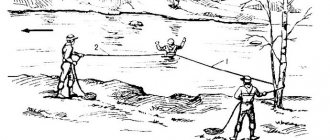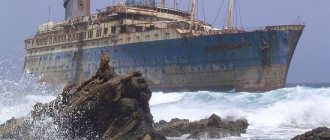Classification of water obstacles
International and Russian classifications divide water obstacles into 6 categories: obstacles of the first category are considered the simplest, and those of the sixth category are the most difficult to pass and life-threatening.
The difficulty category is assigned based on the following factors:
- channel slope;
- water flow in the river in this area;
- extent and concentration of complex elements;
- how potentially dangerous the obstacle to the athlete’s life is.
Movement. OBSTACLES ON THE RIVER AND TECHNIQUES FOR OVERCOMING THEM
®Rafting on an unfamiliar mountain taiga river is full of surprises and adventures. Every turn of the river can hide the most unexpected obstacles, and a group setting out on a journey must be able to detect them in a timely manner and successfully overcome them.
Special literature provides detailed descriptions of various obstacles that may be encountered on the river**. Some features of overcoming obstacles on rafts will be outlined here.
By skillfully using the positive qualities of a raft (strength, stability, unsinkability, etc.), when overcoming obstacles, you can compensate for its main drawback - low maneuverability. It is very important that the raft provides an incomparably better view of the upcoming path than other ships, since the crew rows while standing. In addition, standing on the ridge, you can view the rapids from the influx even with a very steep drop or large standing waves. This allows you to overcome “on the fly” not too difficult rapids, which stretch one after another for many kilometers, while descending through them in boats and kayaks would require detailed reconnaissance from the shore.
Below we discuss the most common obstacles encountered when sailing on rafts.
Riffles and shallows
- are formed where the flow speed decreases and sediments fall out of the water in the form of sand and small stones. On mountain rivers you can find shoals formed by fairly large boulders. Most often, shoals and riffles occur near a convex bank at a bend in the river, at strong widenings of the channel, at the upper and lower ends of the islands. A separate shoal or riffle with a sufficiently deep passage, the so-called trough, is not dangerous for the raft if it is detected in a timely manner. In addition to the shape of the channel, signs of shoals and riffles can be:
1) the color of the water is lighter, yellowish, in shallow places and darker, green, in deep places;
2) the surface of the water - in calm weather the water above the shallows is smooth, but on the main stream it always ripples; in the wind, the wave on the main drain and in general in a deep place is noticeably larger and smoother than above the shallows.
Usually it is possible to see the roll already on the approaches and direct the raft along the main stream through the trough. If there is not enough water and the raft sits on the ground, the crew goes into the water and, using their arms as levers, pushes the ship forward. It makes sense to take it back against a strong current only in rare cases, with very wide and shallow riffles, after first finding the deepest trough, and if necessary, then clearing it of large stones. Sometimes it is easier to unload the raft partially or completely than to pull it back.
If the raft has run aground on its side and is pressed against it by the pressure of the main flow passing nearby, a so-called “slap in the face” should be initiated (Fig. 35). Any log can be used as a “slap”; often a spare row is taken for this purpose. The rowing handle is tied to the forward rongine or boom at the side, and the blade is thrown into the stream at the longer end of a strong rope, which is secured at the stern. You need to make sure that the blade is in a vertical position at all times. The flow puts pressure on the “slap” and pulls the stern off the shallows. The raft moves away from the shoal, as when casting off “in a hole.” Sometimes it is advisable to use both a wag and a “slap in the face” at the same time. On shallow riffles, it is more effective to simultaneously initiate “slaps” from both sides.
Rubble
- clusters of trees washed away by spring waters - often insurmountable for a raft. Tree trunks pile up at the tops of the islands, sometimes completely blocking one of the channels. The raft will freely pass a non-solid blockage, but you should not get too close to it: usually only the upper layers of the flow are more tightly blocked, the water rushes under the blockage with great force and can drag a raft that happens to be nearby there.
Solid blockages form in sections of the river with a low slope and low flow speed, where the flow is split into separate narrow channels, as well as in the upper reaches of small taiga rivers, the width of which does not exceed the height of the surrounding trees. Having encountered a solid blockage, you need to land in advance and, if it is not wide, try to clear a passage in it with axes and saws. When doing such work, you should not waste time trying to find a weak spot in the rubble. If it is not possible to pass the blockage, a new raft is knitted downstream, and sometimes it is possible to partially or completely use the material of the old raft.
Not only a blockage, but also one tree hanging over a fast stream can cause serious trouble. Such trees are more often found on concave banks, near steep yars, where the flow greatly destroys the bank. An overhanging tree can not only throw the yawning raftsmen and their cargo into the water, but also break the oars, row pads, and sometimes lead to the flooding of the raft. You need to rake away from such trees in advance.
Single stones
- underwater and surface - do not pose a danger to the raft if they are detected in advance. The main signs by which you can detect an underwater stone are non-disappearing circles, breakers and oblique jets extending from the top of the stone. It is much more difficult to detect a stone that is located in a threshold, since a standing wave of constant height does not always appear above it. Sometimes in the rapids there are boulders that rise greatly above the average level of the flow and at the same time are continuously flown around by a smooth layer of water 10-15 cm thick. Here you can also find slabs, the flat side of which faces upstream. A rapid smooth stream runs onto such a slab, even if its crest is a meter above the average level of the stream, and runs off it in a weak cascade from the lower steep side. Below such a slab, the water is also relatively calm. In general, at high current speeds, lonely stones may be covered with water from above and difficult to see from the influx. At the same time, their downstream side may be exposed.
The consequences of a raft hitting a rock can vary and depend mainly on the speed of the flow and the height of the rock. The most dangerous are impacts on a rock with the nose of the raft, which sometimes lead to serious accidents (see about them in the last chapter). When struck, the raft most often turns sideways if a stone protrudes from the water, or sits on a stone if it is under water. Turning with a log can lead to an accident if there are other stones nearby. The lightweight bow of a properly constructed raft allows the vessel to sit on the rock with its stern or mid-stay without changing its position relative to the flow.
Before you try to get off the rock, you need to determine where it supports the raft: if closer to the stern, then you should transfer part of the load and the entire crew to the bow, and, pushing against the bottom with poles, move the raft forward; It is also useful to have a “slap in the face”; if closer to the bow, then it is advisable to first turn the raft with its stern downstream. The fastest way to remove a raft from a rock is with a wagami. However, this method is not always applicable, since for this purpose the crew must get into the water (if, of course, the depth and speed of the current allow).
If the impact of the raft on a rock with its bow is extremely dangerous, then the same impact on the side closer to the stern is completely painless. Therefore, when it is clear that it is no longer possible to row away from the stone, you need to lean on it sideways, approximately 1/3 of the length of the raft from the stern. Moreover, sometimes when tacking, placing the raft on a rock can be useful. In Fig. Figure 36 shows such an example.
The riverbed is clogged with stones. The only possible passage was formed by three rocks located one after the other downstream. As soon as the bow of the raft is level with stone No. 1, the bow, and then the stern, is shifted to the right, without, however, getting carried away by this, since stone No. 3 is ahead. They rake only enough so that the raft goes beyond stone No. 2 a little more than halfway. At the moment of hitting rock No. 2, or even a little earlier, the bow of the raft is raked steeply to the left, while continuing to raked the stern to the right. Thanks to this, the raft rotates around stone No. 2. As soon as the stern of the raft begins to break away from this stone, it is also raked to the left. At stone No. 3, the “turn with a blow” is repeated, but in the other direction.
You should take into account the greater inertia of the raft and give and execute commands with greater anticipation than on boats and kayaks. The amount of lead depends on the reaction speed of the crew members, the properties of the raft and the speed of the flow.
She learns with experience.
Thresholds and shivers
- the most dangerous obstacles for rafting along mountain, mountain-taiga rivers and rivers of the foothills and uplands. Rapids form in sections of the river where the channel is cut through basic rocks, the hardness of which is noticeably greater than the hardness of the rocks in nearby areas. Almost always, rapids form on the site of the terminal moraines of disappeared glaciers. At the rapids, the slope of the flow and its speed increase sharply.
The riverbed is often cluttered with rock fragments and stones. In Siberia, less difficult rapids are called shivers.
To confidently descend through a difficult threshold you need experience, which can only be acquired through practice.
The main danger on the threshold is represented by stones and standing waves - shafts. It is especially difficult to pass rapids on rafts that stretch for several kilometers, with a riverbed clogged with randomly scattered stones. To remove a raft from a rock in a rapid, even on a small river, requires considerable effort. On rapids with a large slope and water flow, a raft that has landed on a stone is pressed against the obstacle and the bottom of the riverbed by the oncoming flow with such force that the vessel cannot even move. Standing waves will not sink the raft, but a large wave, especially an oblique one, coming at it somewhat from the side, can wash away people. High standing waves paralyze the work of the forward row, and the raft becomes almost uncontrollable. Horizontal and vertical whirlpools in close proximity to the stream along which the raft passes pose a serious danger. A raft moving at a speed of 8 - 12 m/sec, flying out into slow-moving water or catching it with its bow or side, can completely unexpectedly bury itself deep into it.
The technique of crossing rapids on pole-controlled rapids on small rivers is not much different from going down them in boats and kayaks. You just need to make allowances for the low maneuverability of the raft. The main rule to follow in this case is to go where there is more water. On rapids with a direct drain, they go to the top of the triangle and then along the crests of standing waves. On sharp turns, they stay in the fairway near the concave bank, protecting the salik from falling on it. If the threshold is formed by a mass of boulders, then frequent landings of salik on the stones are inevitable, and you have to “break through”, working with poles and wags (this is the Big Rapid on the Shchugor River).
The technique of descending through rapids on rafts with rowing when swimming along large mountain rivers has its own characteristics. Let's look at a few typical examples.
In sections of a mountain river with an average slope of 2 m per 1 km, sharp turns are often encountered where the flow rolls onto bedrock outcrops. The main stream goes close to the rocks, and the water piles onto the concave bank. The raft pulls like a magnet and grinds against the rocks. This type of twist is often called a “sweet spot.”
An example of such a rapid is the Sayan Shiver on the Kazyr River. On the approaches to it, the stream moves for approximately half a kilometer along a straight channel 80-100 m wide with a clearly visible slope. The “rustle” of stones rolling along the bottom, characteristic of a shiver, can be heard. The turn is formed by a rocky ridge, which first runs perpendicular to the flow, and then turns even steeper. From the right convex bank, a sandbank of boulders, barely covered with water, protrudes far into the stream. The width of the main stream at the turn decreases to 15-20 m, and the flow speed increases sharply. The breaker shaft reaches the middle of the main flow at the end of the drain (Fig. 37). A log thrown in the middle of the riverbed on the upper reach disappears in the waves at the first rocks.
It is obvious that at such a turn the flow is pressed towards the rocks under the action of centrifugal forces proportional to its speed. Therefore, the surface layers of water, which have a higher speed than the bottom layers, will run harder against the rocks and crush them to the bottom. Consequently, at the turn the flow not only falls on the outer bank, but also rotates along its longitudinal axis. It is clear that it is impossible to go through such a threshold along the main stream. They approach it along the right bank. Then they go along the shallows, going around it, not working too hard with both rows to get aground. As soon as the shoal is left behind, turn the bow of the raft 20-30° to the right bank and row towards it at full strength. The raft slides down the inclined stream and passes through the breaker shaft at the last third of it.
A different technique for descending through the rapids with a clean, direct discharge, but with large standing waves in the sub-rapid. As an example, consider the upper part of the Shcheka horn on the same river. Already a few kilometers before the threshold, the speed of the current drops noticeably, the reaches become deeper and wider (up to 150 - 180 m), and the riffles at the turns disappear. It feels like the river is dammed somewhere not far away. Separate outcrops of basic rocks appeared on the shores long ago. The last reach, about 1 m long, ends with a sharp turn to the right. The threshold begins here. Already at the end of the reach, in an even wider channel, there are first individual stones, and then large rocks. The flow is split between them. Its speed is rapidly increasing. Finally, the channels come together to meet the rock wall. Only from here you can see the main drain. Part of the flow is thrown from the wall to the left into a small upper “catch”, and the main mass, after a little hesitation, falls down through a narrow straight passage, cut at a right angle to the right. Its width at the top is no more than 10 m, and the height difference is about 2.5 - 3 m. At the end of the drain, right in the middle of the passage, a particularly high shaft is formed above the fragments of rocks submerged there.
Before the threshold the raft is unloaded. Spare paddles are placed along the longitudinal axis of the raft, one blade forward and the other back. The rows are tied separately, each in two places. The crew should have knives on cords to quickly release the row if necessary. It is better to go down through the threshold with four people, since mooring in the lower “catch” is simple.
The descent begins from the left bank (Fig. 38), since there is a good path along it for carrying loads. Working energetically with rowing, they cross the riverbed and guide the raft between the rocks near the right bank, where there are wider passages and the bulk of the water flows. Above the drain, the raft is pressed with several short strokes to the left side of the cone, since the upper layers of the flow, thrown away from the wall, move with a roll onto the right rocks. The raft must exit to the drain strictly in the direction of the flow.
After the pilot was convinced that the raft had taken its original position, at the command “Osh” and “Row the raft!” the front row is pulled onto the raft and securely secured with ropes, otherwise it will be knocked down or broken by the shaft, and people may also be injured.
From this moment on, the raft is controlled only by the rear row. When draining, due to the increased speed of the vessel, it works well as a rudder. However, you should not make it large in size, since at the drain the current speeds in different places are not the same. If the rowing blade gets into an area with a higher current speed, it will jam in the rower or even break. When jammed, the rower is quickly raised, placing all its weight on the handle, and again lowered in the part of the stream in which the raft is located. Having passed the shaft, at the command “Nose to the left!” they throw the front row into the water and bring the ship to the shore in the lower “catch”.
Headwind
- although the obstacle is not dangerous, in the lower reaches and on lowland rivers it can significantly confuse the traveler’s calculations. Reducing the sailing surface of the surface part of the raft due to more appropriate placement of people and cargo does not give a noticeable result in strong winds. In this case, an “underwater sail” is more effective.
A small but dense spruce or fir is tied by the top and allowed to float in front of the raft. On large rafts you can make several of these “sails”. So that they do not interfere with steering, they can be brought under the raft by securing the end of the rope with an easily untangled knot on the rear ridge. The tree under the raft can also be stretched with a second rope tied to the butt and bow pad. Of course, controlling a raft that carries an “underwater sail” is difficult, so this technique is justified only on simple rivers. Where unexpected obstacles may arise, a fabric “water anchor” is more reliable.
Sailing on rafts along sections of the river where there are artificial obstacles - bridges, ferries, bridges, etc., is not much different from sailing along them on other tourist vessels and is well described in the available literature. The main thing in overcoming these obstacles is to notice them in time in order to be able to land on the shore if necessary. Then you can calmly find out the situation and outline a way to overcome it.
When preparing this section, materials were used from the book by Yu.B. Przhiemsky “The Raft on a Tourist Journey”
Ford for SUVs
Full-fledged SUVs are designed differently. The engine and transmission are located inside the base of the car and are located behind the front axle. The engine is usually mounted longitudinally, so its intake system can be placed closer to the rear wall of the engine compartment. In addition, SUVs are much taller than passenger cars and the air intakes are located on top of the engine, at a height of more than a meter. If you look closely at the body, you will notice on top of the hood and above the wings there are slots with deflectors through which air is sucked in. Due to this arrangement, there is less risk of scooping up water if it gets into an underwater hole.
It is not surprising that the fording depth for such vehicles increases to 50-70 cm. In SUVs like Land Rover with variable ride height, the fording depth is 85 cm. This is approximately the height of the upper edge of the wheel arches. You can drive through deeper areas, but only be careful.
When passing a puddle or a small river, you should not drive the wave in front of you. Water should not flood the hood, otherwise there is a risk of it getting into the air intakes. The wave is dangerous because it creates increased pressure and there is a risk of moisture penetration into closed components and technical systems. Then problems with electronics and electricity may begin.
Don't drive the wave. How to drive in rainy weather? More details
The optimal speed for overcoming water obstacles for all types of cars is 5-7 km/h.











